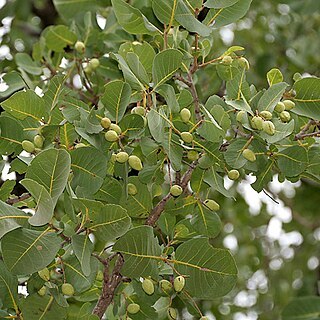A deciduous tree up to 6-10 m tall. The bark is dark grey and rough. It loses its leaves during the year. The leaves are smooth and broadly oval. They are simple and 5-15 cm long by 4-6 cm wide. They are alternate or clumped together in rings. They are normally near the ends of twigs. There are usually 1 or 2 flat glands at the base of the leaf. The flowers are white and contain both sexes. They occur in loose spikes. The fruit is 12-20 mm long by 8-15 mm wide. They occur in spikes in the axils of leaves. They can hang along stalks. There is one seed inside. The seed is 8-9 mm by 2 mm. The flesh is edible.

